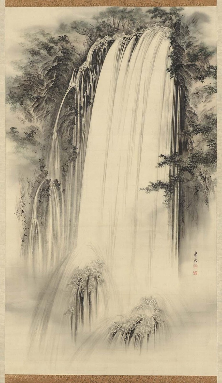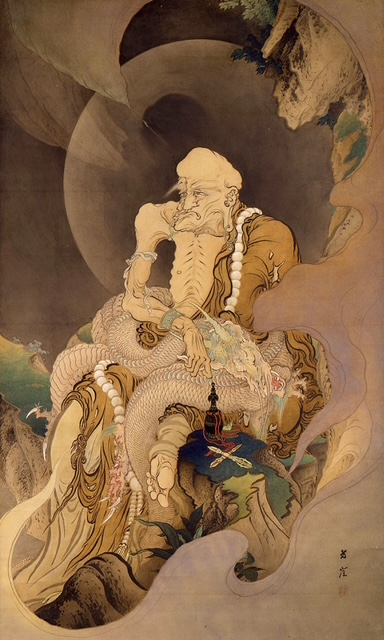

Shinto/Shang
Fall - Fortnight 16 (Earth+Earth)
![]() Festival/Nov
4: Shamans of Shinto and Shang.
Purity and power of nature, sensing the essence (Kami) in everything and
everyone. The pre-buddhist pre-tao animistic traditions of northern China
and Japan. Lao-Tzu.
Festival/Nov
4: Shamans of Shinto and Shang.
Purity and power of nature, sensing the essence (Kami) in everything and
everyone. The pre-buddhist pre-tao animistic traditions of northern China
and Japan. Lao-Tzu.
Shang/Shinto
The Shang Dynasty (c. 1600–1046 BCE) and early Shinto (c. 3rd century BCE) shared animistic roots, with Shang oracle bones and Korean Mu shamans venerating kami in nature. Shinto altars and grounding meditations connected practitioners to earth’s purity, sensing kami everywhere. Their unique idea of a matriarchal divine essence in all things predates later patriarchal shifts.
Lao Tzu
Lao Tzu, traditionally dated to c. 6th century BCE (though possibly legendary), authored the Tao Te Ching, foundational to Taoism, emerging from Shang animism. Shinto/Zen prostrations aligned personal nature with universal flow, reflecting experiential certainty. His distinctive concept of wuwei (nonaction) unveiled a natural order within chaos.
Chuang Tzu
Chuang Tzu (c. 369–286 BCE), a Taoist philosopher,
expanded Lao Tzu’s teachings in the Zhuangzi, emphasizing spontaneity.
Shinto salt ceremonies purified the personal within the universal, fostering
inquiry into kami. His unique parabledriven approach revealed unity through
paradoxical observation.
| Shang Matriarchal Kingdom/Shinto 16th BCE Bone Oracles, Shinto, Kami in all...Korean Mu | Lao Tzu 6th c BCE | Chuang-Tzu 286 CBC |
| Shinto altars | Shinto/Zen buddhist prostrations | Shinto salt ceremony |
| Kotoamatsu-kami in Heaven | Izanagi and Izanami | Shinto kami |
1. The Personal within the Universal:
At this level the Universal, ones Original
Nature, dawns within the Personal. A new way of living in the world is
unveiled, one grounded in experiential certainty, observation, and inquiry.
|
|
|
|
|
|
|
|
|
|
|
|
|
|
|
|
|
| RITE | - | - | - | - | - | - | - | - | - | - | - | - | - | - | - |
| PRACTICE | Flower Festival | Neidan:
1. Grounding Meditation - Sitting or lying on the earth to feel its stability. Shugendo:
|
2. Earth Element Mantra - Reciting mantras to connect with
earth's nurturing energy.
2. Grounding Meditation - Sitting or lying on the earth to connect with its energy. |
3. Stomach-Spleen Breathing - Breathing focused on digestion
and grounding.
3. Stone Stacking - Building cairns as offerings or for
focus.
|
4. Middle Dantian Activation - Focusing energy in the middle
dantian for balance.
4. Forest Bathing (Shinrin-yoku) - Immersing in nature for healing and grounding. |
5. Earth Qi Gathering
- Drawing earth energy into the body for stability.
5. Earth Mantras - Reciting mantras to honor earth deities or spirits. |
6. Late Summer Reflection - Meditating on earth's abundance
during this season.
6. Soil Touching - Touching or feeling the earth to gain strength and stability. |
7. Earth Cycle Harmonization - Aligning personal energy
with the earth's cycles.
7. Pilgrimage to Sacred Sites - Visiting places considered powerful earth spots. |
8. Nourishing the Spleen - Exercises to support the spleen's
function.
8. Grounding Exercises - Physical practices to align with
the earth's energy.
|
9. Earth Element Sound - Using the healing sound associated
with earth.
9. Gardening as Meditation - Cultivating plants as a spiritual
practice.
|
10. Center of the Wheel - Meditating on being the center
of the elemental cycle.
10. Goma with Earth Offerings - Using earth elements in
fire rituals.
|
11. Earth Alchemy - Transforming personal energies into
grounding forces.
11. Cave Meditation - Retreats into caves for introspection and connection.. |
12. Earthly Immortality - Practices using earth energy
for longevity.
12. Burial Mounds Practices - Rituals near ancient burial sites for spiritual insight |
Shugyo Fast | Shugyo Fast |
| STUDY | Shinto | - | - | - | - | Tao Te Ching | - | - | - | - | Chang Tzu | - | - | - | - |
| MEDITATION | - | - | - | - | - | - | - | - | - | - | - | - | - | - | - |
Group 1: Earth (Days 1–15)
Theme: Grounding, stability, and laying the foundation
for transformation (Neidan Stage 1: Refining Jing, Laying the Foundation).
Earth represents the body and physical discipline, aligning with Zen’s
emphasis on work and mindfulness.
Feast (Day 1): Prepare and eat a Shojin Ryori meal, respecting each grain, as per Dogen’s Tenzo Kyokun: “Do not let a single grain fall to the ground.”
Part 1: Jing (Essence) – Physical Practices
Focus: Practical actions, Zen work ethic, cleanliness,
and bodily discipline.
1. Sweeping the Temple Floor
Basis: Zen’s emphasis on manual
labor as meditation (Dogen’s Shobogenzo: “To sweep the floor is to sweep
the mind”).
Exercise: Sweep a small area (indoor
or outdoor) with a broom, focusing on each stroke as a cleansing of mental
clutter. Visualize dust as distractions being cleared.
2. Mindful Dishwashing
Basis: Dogen’s Tenzo Kyokun on respecting
utensils and food preparation.
Exercise: Wash dishes by hand, feeling
the water and soap, treating each plate as sacred. Contemplate Dogen’s
words: “Handle even a single leaf of green as if it were the Buddha.”
3. Walking Meditation (Kinhin)
Basis: Soto Zen’s walking meditation
to cultivate mindfulness.
Exercise: Walk slowly in a circle
or straight path, synchronizing breath with steps (inhale two steps, exhale
two steps). Focus on the earth beneath your feet.
4. Tending a Small Plant
Basis: Chan/Zen farming as spiritual
practice, reflecting Neidan’s nurturing of Jing.
Exercise: Water and care for a potted
plant, visualizing your essence being nourished as you nurture the plant’s
roots.
5. Salt Purification Ritual
Basis: Shinto’s salt ritual for
cleansing impurities.
Exercise: Sprinkle a pinch of salt
around your space, then rub a small amount between your palms, visualizing
negative energies dissolving into the earth.
Part 2: Qi (Energy) – Mental Focus and Koans
Focus: Cultivating energy through contemplation
and Zen koans.
6. Koan: Dogen’s Mountain Walking
Basis: Dogen’s Shobogenzo: “Mountains
walk, clouds walk.”
Exercise: Sit in Zazen and contemplate
this koan. Ask: “How does a mountain walk?” Let thoughts arise and dissolve
without clinging.
7. Breathing the Cauldron
Basis: Neidan’s lower Dantian breathing
to gather Qi.
Exercise: Sit cross-legged, hands
on lower abdomen. Inhale deeply, visualizing golden light pooling in your
Dantian (below navel). Exhale, releasing tension.
8. Koan: The Sound of One Hand
Basis: Rinzai Zen’s famous koan
to break dualistic thinking.
Exercise: Sit in Zazen, asking:
“What is the sound of one hand clapping?” Hold the question without seeking
an answer.
9. Chanting “Mu”
Basis: Rinzai Zen’s use of “Mu”
(from Gateless Gate) to exhaust the mind.
Exercise: Chant “Mu” softly with
each exhale for 10 minutes, letting the sound resonate in your chest.
10. Contemplating the Diamond Mandala
Basis: Shingon’s Diamond Mandala,
symbolizing indestructible wisdom.
Exercise: Visualize a radiant
diamond at your heart, its facets reflecting all phenomena. Contemplate:
“All is one, one is all.”
Part 3: Shen (Spirit) – Visualization and
Altar Work
Focus: Spiritual refinement, visualization, and
altar practices.
11. Creating an Earth Altar
Basis: Neidan’s use of symbolic
spaces; Zen’s simplicity in altars.
Exercise: Arrange a small
altar with a stone, candle, and incense. Meditate before it, visualizing
your body as a mountain anchoring your spirit.
12. Wall-Gazing Meditation
Basis: Bodhidharma’s nine-year
wall-gazing (Soto Zen).
Exercise: Sit facing a blank
wall, letting thoughts dissolve. Visualize your mind as a still lake, reflecting
the wall’s emptiness.
13. Visualizing the Golden Embryo
Basis: Neidan’s early stage
of forming the Immortal Embryo.
Exercise: Sit in meditation,
visualizing a golden seed in your Dantian, glowing with each breath, symbolizing
your spiritual potential.
14. Contemplating a Rock Garden (Fast Day)
Basis: Zen rock gardens as
tools for contemplation; Neidan’s focus on stillness.
Exercise: Sit before a small
arrangement of stones (or visualize a rock garden). Contemplate their stillness
as a reflection of your eternal nature, preparing for life after death.
15. Offering to Hungry Ghosts (Fast Day)
Basis: Buddhist offerings
to ease suffering of spirits.
Exercise: Place a small bowl
of rice on your altar, dedicating it to hungry ghosts. Meditate on compassion,
visualizing their liberation as your own.
Group 2: Water (Days 16–30)
Theme: Fluidity, adaptability, and refining Qi (Neidan Stage 2: Refining Qi, Harmonizing Yin-Yang). Water aligns with Zen’s flow and Shugendo’s ascetic connection to nature.
Feast (Day 16): Prepare a Shojin Ryori meal with
seaweed and rice, honoring water’s life-giving essence.